Heat Transfer and Entropy Generation in a Lithium-ion Battery Pack Against Battery Spacing and Discharge Rate
IF 2.8
4区 工程技术
Q2 ENGINEERING, MECHANICAL
引用次数: 0
Abstract
Three-dimensional continuity, momentum and energy equations have been solved in a battery pack of a unit module with 3×3×3 and 4×4×4 Li-ion cells to obtain the flow field and temperature distribution around the batteries. The battery spacings in ×, y and z directions (S×, Sy and Sz) have been varied in a wide range to obtain the optimum configuration for the maximum heat transfer and minimum entropy generation. Air is pumped through the battery pack with Reynolds number (Re) varying in the laminar range from 400 to 2000. The results are plotted in terms of average surface Nu over the battery surface and average volumetric temperature of the battery and air. It is found that the temperature of the battery pack remains almost constant against Sx. However, a significant rise in battery temperature is observed when we increase Sy. The scenario becomes different when spacing is varied in the z-direction. An optimum spacing for the minimum temperature of the battery pack is obtained at Sz/Dh = 0.03. In each case, the maximum temperature is seen on the batteries present at the top and bottom corners of the outlet. Among all the cases, the maximum temperature of 355 K has been found in 4×4×4 cells with a 3.6 C discharge rate at Sy/Dh of 0.07133. It is numerically and theoretically proved that Nu and the non-dimensional volumetric average temperature inside the pack are independent of the heat generation rate inside the battery pack.锂离子电池组的传热和熵生成与电池间距和放电速率的关系
求解了含有3×3×3和4×4×4锂离子电池的单元模块电池组的三维连续性、动量和能量方程,得到了电池周围的流场和温度分布。电池在x, y和z方向(sx, Sy和Sz)上的间距在很大范围内变化,以获得最大传热和最小熵产的最佳配置。空气被泵入电池组,雷诺数(Re)在层流范围从400到2000变化。结果以电池表面的平均表面Nu和电池与空气的平均体积温度绘制。发现电池组的温度对Sx几乎保持恒定。然而,当我们增加Sy时,可以观察到电池温度的显著上升。当间距在z方向上变化时,情况就不同了。在Sz/Dh = 0.03时,获得了电池组最低温度的最佳间距。在每种情况下,在插座的顶部和底部角落的电池上都可以看到最高温度。其中,4×4×4电池的最高温度为355 K,放电率为3.6 C, Sy/Dh为0.07133。从数值和理论上证明了Nu和电池组内无因次体积平均温度与电池组内产热率无关。
本文章由计算机程序翻译,如有差异,请以英文原文为准。
求助全文
约1分钟内获得全文
求助全文
来源期刊
自引率
0.00%
发文量
182
审稿时长
4.7 months
期刊介绍:
Topical areas including, but not limited to: Biological heat and mass transfer; Combustion and reactive flows; Conduction; Electronic and photonic cooling; Evaporation, boiling, and condensation; Experimental techniques; Forced convection; Heat exchanger fundamentals; Heat transfer enhancement; Combined heat and mass transfer; Heat transfer in manufacturing; Jets, wakes, and impingement cooling; Melting and solidification; Microscale and nanoscale heat and mass transfer; Natural and mixed convection; Porous media; Radiative heat transfer; Thermal systems; Two-phase flow and heat transfer. Such topical areas may be seen in: Aerospace; The environment; Gas turbines; Biotechnology; Electronic and photonic processes and equipment; Energy systems, Fire and combustion, heat pipes, manufacturing and materials processing, low temperature and arctic region heat transfer; Refrigeration and air conditioning; Homeland security systems; Multi-phase processes; Microscale and nanoscale devices and processes.

 求助内容:
求助内容: 应助结果提醒方式:
应助结果提醒方式:


